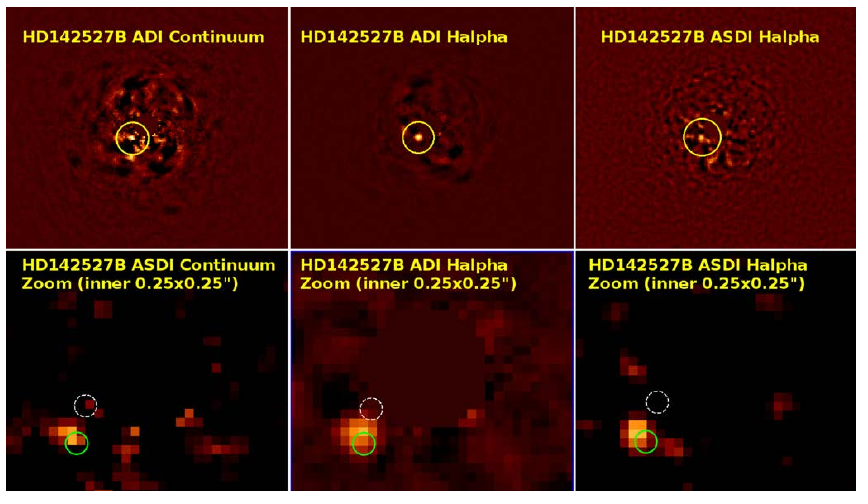
We utilized MagAO to obtain very high-resolution visible light images of HD142527 with MagAO’s VisAO science camera. In the median seeing conditions of the 6.5m Magellan telescope (0.5 − 0.7′′), we find MagAO delivers 24-19% Strehl at Ha (0.656 mm). We detect a faint companion (HD142527B) embedded in this young transitional disk system at just 86.3±1.9 mas (~12 AU) from the star. The companion is detected in both Halpha and a continuum filter (Dmag=6.33±0.20 mag at Ha and 7.50±0.25 mag in the continuum filter). This provides confirmation of the tentative companion discovered by Biller and co-workers (a past graduate of Dr. Close, who is now a professor at the University of Edinburgh) with sparse aperture masking at the 8m VLT.
MagAO found that the Halpha emission from the ~0.25 solar mass companion (EW=180 Angstroms) implies a mass accretion rate of ~5.9×10-10 Msun/yr, and a total accretion luminosity of 1.2% Lsun. Assuming a similar accretion rate, we estimate that a 1 Jupiter mass gas giant could have considerably better (50-1000x) planet/star contrasts at Halpha than at H band (COND models) for a range of optical extinctions (3.4-0 mag). We suggest that 0.5-5 Mjup extrasolar planets in their gas accretion phase should be much more luminous at Halpha than in the NIR. This is the motivation for our new MagAO GAPplanetS survey for extrasolar planets which is a key project for the MagAO team, and in particular senior PhD student Kate Follette who has lead most of the GAPplanets work to date.
Here is the Astrophysical Journal abstract:
“We utilized the new high-order 585 actuator Magellan Adaptive Optics system (MagAO) to obtain very high-resolution visible light images of HD 142527 with MagAO’s VisAO science camera. In the median seeing conditions of the 6.5 m Magellan telescope (0.”5-0.”7), we find MagAO delivers 24%-19% Strehl at Halpha (0.656 mum). We detect a faint companion (HD 142527B) embedded in this young transitional disk system at just 86.3 ± 1.9 mas (~12 AU) from the star. The companion is detected in both Halpha and a continuum filter (Deltamag = 6.33 ± 0.20 mag at Halpha and 7.50 ± 0.25 mag in the continuum filter). This provides confirmation of the tentative companion discovered by Biller and co-workers with sparse aperture masking at the 8 m Very Large Telescope. The Halpha emission from the ~0.25 solar mass companion (EW = 180 Å) implies a mass accretion rate of ~5.9 × 10-10 M sun yr-1 and a total accretion luminosity of 1.2% L sun. Assuming a similar accretion rate, we estimate that a 1 Jupiter mass gas giant could have considerably better (50-1000×) planet/star contrasts at Halpha than at the H band (COND models) for a range of optical extinctions (3.4-0 mag). We suggest that ~0.5-5 M jup extrasolar planets in their gas accretion phase could be much more luminous at Halpha than in the NIR. This is the motivation for our new MagAO GAPplanetS survey for extrasolar planets.”
You can read more about it here:
Close, L. M., et al. “Discovery of Hα Emission from the Close Companion inside the Gap of Transitional Disk HD 142527”
ApJ, 781, L30, 2014 ADS arxiv preprint